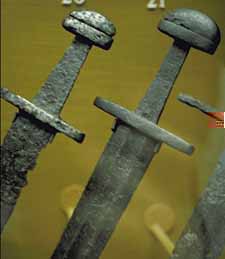Royal Armouries
The following medieval swords were on display in the Royal
Armouries in Leeds in February, 1998. The accession numbers, copied
from the exhibit labeling, may be cross referenced with descriptions
and illustrations in Dufty
(1974) using the tables on pages 151 - 153.
War Gallery
IX.14 - Medieval sword, hand and a half, with an oval
wheel pommel with raised centers and a crossguard with distally
widening quillions in bow-tie fashion. The greatly corroded blade
of flattened diamond cross-section is narrow and tapers along
straight (except for corrosion) edges to an acute point. Labeled
possibly German, late 14th Century (Dufty plate 4c).
 IX.859
- Viking age sword with two part iron tea-cosy pommel and moderately
short, thick cross-guard. An obscured iron-inlay is present on
the blade. 10th to 11th Century (Dufty plate 1b, Laking figure 18). This is the sword to the
left in the adjacent snapshot from the old exhibit at the White
Tower. The sword on the right (Dufty plate 1a) is also on display
in the new Royal Armouries, but is unlabeled in a yet incomplete
case.
IX.859
- Viking age sword with two part iron tea-cosy pommel and moderately
short, thick cross-guard. An obscured iron-inlay is present on
the blade. 10th to 11th Century (Dufty plate 1b, Laking figure 18). This is the sword to the
left in the adjacent snapshot from the old exhibit at the White
Tower. The sword on the right (Dufty plate 1a) is also on display
in the new Royal Armouries, but is unlabeled in a yet incomplete
case.
IX.915 - Medieval sword, hand and a half or two handed,
with a long wide blade showing a mild to moderate taper. A single
shallow fuller runs about 40% of the blade's length. An Alexandria
(Egypt) arsenal accession inscription is present in the fuller.
Described in Mann
(1963) (Dufty plate 4d).
IX.1027 - Medieval sword with a moderately wide and
mildly tapering blade with a narrow fuller running 80 to 90 percent
of blade length. The iron pommel is of disc form and the iron
crossguard is long and straight. Labeled as being possibly English,
early 13th Century (Dufty plate 2b).
IX.1081 - Medieval sword with rounded "beehive"
shaped iron pommel and slender, long cross-guard. Labeled early
12th Century (Dufty plate 1c).
IX.1082 - Medieval sword with a moderately long and
broad repaired blade with a very narrow fuller running 80 to 90
percent of blade length. A blade inscription inlaid in white metal
(tin?) is present. The pommel is of rounded brazil-nut form and
the crossguard in of moderate length and slender cross-section.
Labeled late 12th Century (Dufty plate 2c).
IX.1084 - Medieval sword, hand and a half, with a latten
wheel pommel with raised center and quillions flaring slightly
distally towards the blade. A running wolf and other latten inlays
are present. Labeled German 1350 - 1400 (Dufty plate 4a).
IX.1085 - Medieval sword with a disc pommel. Labeled
late 14th Century.
IX.1106 - Medieval sword of moderate length and width,
tapering along straight edges to an acute point. The blade has
a flattened diamond cross section. Labeled late 14th Century,
from Lake Constance (Dufty plate 4f).
IX.1107 - Medieval sword with a moderately tapering
wide blade with a wide fuller running about two-thirds of the
blade length. The iron cross guard includes a small triangular
projection towards the blade and has quillions partially downturned
at the tips at about a 45 degree angle. The iron pommel has less
sharply upturned tips giving a profile resembling the arm rest
of a crutch. Labeled second half of 13th Century (Dufty plate
2d).
IX.1441 - Medieval sword with a beveled wheel pommel
and inlaid shield designs in latten on the blade. Labeled late
13th Century.
AL.23.5 - Medieval sword with iron brazil nut pommel,
long slender iron cross-guard, and geometric latten inlays on
the blade. (Personally, I'd surmise an earlier date than the mid-13th
Century date in the exhibit labeling and in Dufty (compare with
the INGELRII at Kelvingrove in Glasgow) (Dufty plate 3b).
AL.23.6 - Medieval sword with a short fuller, a running
wolf mark and down-turned quillions. Labeled possibly German,
late 14th Century.
AL.23.96 - Medieval sword with a short fuller and disc
pommel. Labeled circa 1300.
AL.40.1 - Medieval sword, hand and a half, of Oakeshott's
type XV with an Alexandria (Egypt) arsenal accession inscription
dating to 1419. (On loan from Leeds Castle).
incomplete and in progress,
more to come
Return to museums
~ Return to site
home page ~ framed
~ unframed
 IX.859
- Viking age sword with two part iron tea-cosy pommel and moderately
short, thick cross-guard. An obscured iron-inlay is present on
the blade. 10th to 11th Century (Dufty plate 1b, Laking figure 18). This is the sword to the
left in the adjacent snapshot from the old exhibit at the White
Tower. The sword on the right (Dufty plate 1a) is also on display
in the new Royal Armouries, but is unlabeled in a yet incomplete
case.
IX.859
- Viking age sword with two part iron tea-cosy pommel and moderately
short, thick cross-guard. An obscured iron-inlay is present on
the blade. 10th to 11th Century (Dufty plate 1b, Laking figure 18). This is the sword to the
left in the adjacent snapshot from the old exhibit at the White
Tower. The sword on the right (Dufty plate 1a) is also on display
in the new Royal Armouries, but is unlabeled in a yet incomplete
case.